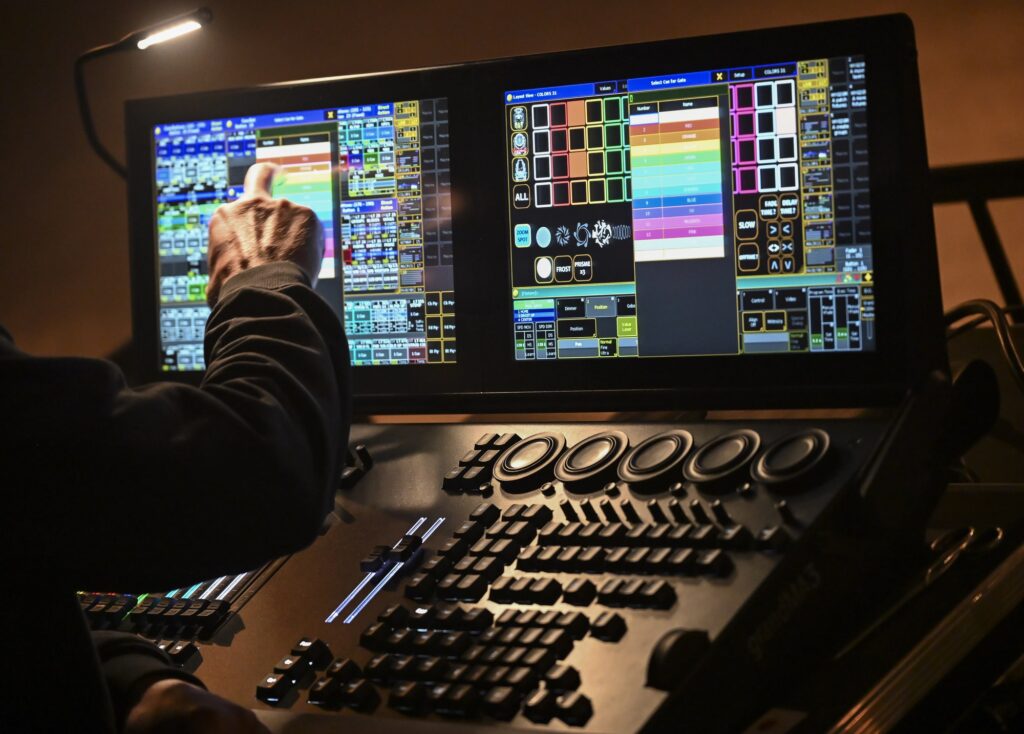An AV system lets you see and hear presentations, videos, or live events clearly. It brings together devices like cameras, microphones, speakers, and screens so that sound and images reach everyone in the room. Basically, an audiovisual system helps you share info in a way that’s easy for people to follow.

Running a meeting, hosting a conference, or managing a public event? Your AV system shapes how your message is heard and seen. When the setup works well, it just makes everything simpler and less stressful.
Getting familiar with the parts of an AV system can save you some headaches. It’s easier to pick the right gear and get more out of your setup, no matter the event.
Key Components of an AV System
An AV system has several main parts that work together to deliver clear sound, sharp visuals, and easy control. Each one matters—audio, video, and control pieces all contribute to a smooth experience. Knowing what’s what can help you build or tweak a system that actually fits your needs.
Audio Equipment
Audio gear covers microphones, speakers, and amplifiers, and each affects sound quality. There are all sorts of microphones—wireless, wired, handheld, lapel—depending on what you’re doing. Speakers range from tiny background units to big, concert-ready ones.
Amplifiers boost the audio so it fills the room without sounding awful. Sound reinforcement systems combine these pieces to keep voices and music clear, even in big spaces. Honestly, good audio equipment is non-negotiable if you want to avoid feedback and those annoying sound glitches.
Video Equipment
Video equipment is anything you use to show images or video. Projectors and screens are classics for big presentations or movie nights. Monitors and LED displays are great where you need bright, sharp pictures—think classrooms or control centers.
Cameras let you capture live video for streaming or recording. Video switchers make it easy to jump between different video sources. If you want something flashier, video walls and interactive displays can make things pop. All these options help deliver visuals that actually look good to your audience.
Control and Integration Systems
Control and integration systems are what let you manage your AV gear from one spot. This usually means a control processor and some sort of user interface—maybe a touch panel or a remote. A well-thought-out control setup makes it much less intimidating for anyone to use the system.
Automation can be a lifesaver, handling things like powering up devices or adjusting sound levels on a schedule. Network connectivity helps everything talk to each other. You can tweak these controls to match your preferences and make life easier.
Supplementary Components
Supplementary parts add extra features or boost performance. Lighting controls set the mood or make sure everyone can see what’s happening. Surveillance cameras, access control, and emergency alerts can tie in for safety and security.
Intercoms let people talk across a building or campus. Media players store or stream content, so your video displays aren’t just for show. These extras make your AV system more flexible and useful, whatever the setting.
AV System Applications and Solutions
AV systems play a big role in how we communicate, learn, and entertain. They make meetings run better, classrooms more interactive, and public spaces more inviting. You’ll find setups tailored for all sorts of needs, usually designed to be pretty user-friendly.
Corporate and Conference Room AV
Corporate AV systems keep communication smooth and meetings efficient. This usually means video conferencing, big screens, and sound systems built for boardrooms and meeting spaces.
Custom designs focus on clear audio, crisp video, and controls that don’t require an IT degree. Conference room AV often includes panels or apps to handle lighting, screens, and sound from one spot.
If you work with an experienced AV integrator, they’ll help you find something that fits your budget and tech needs. Reliable AV means fewer distractions and more time to actually get work done.
Educational and Training Environments
Educational AV systems change the way teachers teach and students learn. Classrooms and lecture halls get a boost from interactive whiteboards, smartboards, and solid audio so lessons aren’t a snooze.
Lecture capture lets students go back and review what they missed. Training rooms benefit from collaboration tools and multimedia displays that make instructions clearer.
A good educational AV setup should encourage interaction and make things accessible, supporting different teaching styles and group sizes. It’s not just about the tech—it’s about making learning more engaging.
Hospitality, Retail, and Public Spaces
In hospitality and retail, AV brings the mood and keeps people informed. Digital signage or menu boards can update content on the fly.
Interactive kiosks help customers find what they need fast. Background music systems set the vibe without being overbearing.
Hospitality AV should be easy to use and blend in with the surroundings. In retail, smart AV keeps people engaged and makes your place stand out.
Home Theater and Residential Setups
Home theaters bring that movie magic right into your living room. You can go for surround sound, big TVs, or projectors, and smart controls that keep things simple and fun.
Custom home AV setups focus on ease of use and looking good in your space. Often, these systems tie in with home automation, so you can control lights, blinds, and AV gear from one device.
Your home AV should sound and look great, but also fit your lifestyle. When it works well, relaxing with a movie or music just feels effortless.
Advanced Features and Emerging AV Technologies
Today’s AV systems come packed with tools that make communication, collaboration, and sound quality better than ever. These features help you work smarter, keep people engaged, and manage live events without a hitch. You’ll notice how tech supports video calls, interactive presentations, and good audio in all sorts of situations.
Video Conferencing and Collaboration
Modern video conferencing systems are a big step up. Wireless presentation tools let you share screens without fumbling with cables, so everyone can jump in easily. Software updates often add things like AI noise reduction, auto-framing, and live transcription.
These solutions support hybrid work, connecting people in the office and at home with smooth video and sound. Telemedicine also uses this tech to deliver quick, clear care. Media players built in mean you can play content during meetings without a hitch.
Interactive and Immersive Technologies
Interactive displays and whiteboards make meetings and classes more hands-on. You can write, draw, or control content right on the screen. Kiosks give visitors info while making the experience more engaging.
Projection mapping turns regular surfaces into eye-catching displays, adding depth and interest. Video walls combine multiple screens for a huge, dynamic look. These tools help you get your message across in a way people actually remember.
Live Events and Sound Reinforcement
Live events need solid sound reinforcement and PA systems. These make sure everyone can hear, even in big venues. With modern streaming gear, you can reach online audiences too.
Sound setups use multiple speakers, mixers, and microphones so you can tweak volume and quality just right. Works great for conferences, concerts, or any event where audio really matters.
Maintenance, Troubleshooting, and Expert Services
Keeping your AV system in shape takes regular care, quick fixes when things go wrong, and sometimes a pro to handle the tricky stuff. Good maintenance keeps everything running longer and helps you avoid those annoying breakdowns.
Routine Care and Maintenance
Give your AV system a regular once-over. Clean screens, projectors, and speakers to keep dust from wrecking the picture or sound. Check cables and connectors—loose wires can be the culprit behind weird issues.
Don’t forget to update the software and firmware to fix bugs or get new features. Scheduling regular maintenance visits from an AV pro is smart, especially if you’ve got a custom or complex setup.
Little things, like keeping vents clear and making sure nothing overheats, really do help you avoid big repair bills. Some Inland AV providers offer ongoing maintenance plans so you don’t have to stress about it.
Troubleshooting and Optimization
If something’s off, start with the basics—power, wiring, input sources. A lot of problems are just simple settings or loose cables.
For tougher issues, diagnostic tools or remote support can save you time. Optimization means dialing in your settings for the best experience, like tuning picture quality or balancing audio.
Regular system reviews help catch problems early and keep everything working together smoothly.
Professional Installation and Support
Getting a pro to install your AV system makes a huge difference. They’ll handle placement, wiring, and programming to fit your space and how you plan to use it.
Experts also customize setups for places like conference rooms or classrooms, making them easier to use and less prone to mistakes. Service teams can handle repairs and maintenance to keep things running longer.
Look for providers who offer both on-site and remote support—they’ll get you back up and running fast. Companies specializing in Inland AV can bundle installation, support, and maintenance for a smoother experience. Good service plans mean you spend less time worrying and more time actually using your AV system.
Frequently Asked Questions

Here you’ll find straightforward answers about what AV means, what kinds of devices fall under that umbrella, how much it all might cost, and what an AV system actually does. If you’re new to this, these basics should help you get a sense of what to look for when picking out AV gear.
What does an AV stand for?
AV stands for Audio-Visual. Basically, it’s technology that combines sound and visuals.
The term covers equipment that manages audio signals and video output—think home theaters, presentations, or any event setup where you need both sight and sound working together.
What is an AV device?
An AV device is any hardware that deals with audio or video signals—processing, sending, or receiving them. Stuff like speakers, microphones, projectors, and AV receivers all count.
Usually, these devices link up to create a full system that delivers both sound and visuals for entertainment or communication. AV devices are designed to work together, not just alone.
How much does an AV system cost?
AV system prices are all over the place. A simple setup might run a few hundred bucks, but if you want something high-end—multiple rooms, custom features, the works—you could be looking at several thousand.
It really depends on your space, how many devices you need, and how picky you are about quality. Brand names and installation fees can push the total higher than you might expect, so it’s smart to plan for those, too.
What is an AV system?
An AV system brings together audio and video devices into one setup, whether for entertainment or presentations. You’ll usually find things like speakers, amplifiers, screens, and some kind of control unit in the mix.
It’s all about getting better sound and visuals at home or in the office. Some setups even have smart features, so you can stream or control what’s playing in different rooms—pretty handy, honestly.

